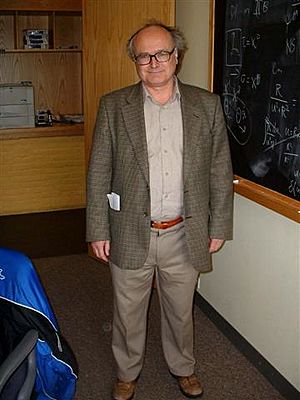Gary Gibbons facts for kids
Quick facts for kids
Gary Gibbons
|
|
|---|---|

Gary Gibbons at Harvard University, c. 2005
|
|
| Born |
Gary William Gibbons
1 July 1946 Coulsdon, London, England
|
| Education | Purley County Grammar School |
| Alma mater | University of Cambridge (BA, PhD) |
| Known for |
|
| Awards |
|
| Scientific career | |
| Fields |
|
| Institutions |
|
| Thesis | Some aspects of gravitational radiation and gravitational collapse (1973) |
| Doctoral advisor | |
| Doctoral students | Chris Hull |
Gary William Gibbons (born 1 July 1946) is a British theoretical physicist. He studies how gravity works, especially in extreme places like black holes.
Contents
Early Life and Education
Gary Gibbons was born in Coulsdon, a town in London, England. He went to Purley High School for Boys for his early education. Later, he studied at the University of Cambridge.
In 1969, he started his research as a student under a scientist named Dennis William Sciama. When Sciama moved to another university, Gary Gibbons became a student of the famous physicist Stephen Hawking. He earned his PhD from Cambridge in 1973.
Career and Research in Physics
Gary Gibbons has spent most of his career at the University of Cambridge. He also worked for a short time at the Max Planck Institute for Physics in Germany during the 1970s.
He became a full professor at Cambridge in 1997. In 1999, he was made a Fellow of the Royal Society. This is a very special honor for scientists in the United Kingdom. In 2002, he became a Fellow of Trinity College, Cambridge.
Understanding Black Holes
After finishing his PhD, Gary Gibbons focused on the quantum theory of black holes. Black holes are areas in space where gravity is so strong that nothing, not even light, can escape.
He worked with another physicist, Malcolm Perry. They studied how black holes have properties similar to heat, like temperature. This helped scientists understand that black holes are not just empty voids.
Quantum Gravity and Black Hole Heat
Gary Gibbons also worked with Stephen Hawking on something called the "Euclidean approach" to quantum gravity. This is a way to use math to understand how gravity works at a very tiny, quantum level.
This approach helped them figure out how black holes can have "thermodynamics." This means black holes can have properties like temperature and entropy, just like a hot object. It was a big discovery that showed a surprising link between gravity and heat.
Later Research and Geometry
In more recent years, Gary Gibbons has studied other advanced topics in physics. These include supergravity, p-branes, and M-theory. These areas are often connected to string theory, which tries to explain all the forces of nature.
He is very interested in how different shapes and spaces (geometry) can be used to understand physics. His work helps us learn more about the universe and its fundamental rules.
Awards and Recognition
Gary Gibbons was elected a Fellow of the Royal Society (FRS) in 1999. This award recognized his important work in general relativity and the quantum theory of gravity.
He was honored for developing the Euclidean approach to quantum gravity. This method helped explain why black holes and expanding universes have thermal properties. His research showed a deep connection between gravity and thermodynamics. He also discovered many important "gravitational instantons" and studied their features.
His work also explored how the shape of spacetime can change. He is known worldwide as a leader in his field.

